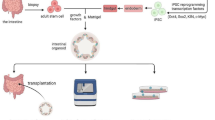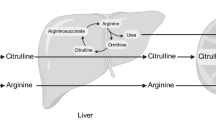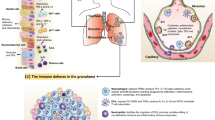Abstract
Although intestinal flora are crucial in maintaining immune homeostasis of the intestine, the role of intestinal flora in immune responses at other mucosal surfaces remains less clear. Here, we show that intestinal flora composition critically regulates the toll-like receptor 7 (TLR7) signaling pathway following respiratory influenza virus infection. TLR7 ligands rescued the immune impairment in antibiotic-treated mice. Intact microbiota provided signals leading to the expression of mRNA for TLR7, MyD88, IRAK4, TRAF6, and NF-κB at steady state. Significant changes in the composition of culturable commensal bacteria reduced the expression levels of components of the TLR7 signaling pathway. Our results reveal the importance of intestinal flora in regulating immunity in the respiratory mucosa through the upregulation of the TLR7 signaling pathway for the proper activation of inflammasomes.






Similar content being viewed by others
References
Chervonsky A (2009) Innate receptors and microbes in induction of autoimmunity. Curr Opin Immunol 21:641–647
Raroff Nahoum S, Paglino J, Eslami Varzaneh F et al (2004) Recognition of commensal microflora by toll-like receptors is required for intestinal homeostasis. Cell 118:229–241
Ichinohe T, Pang IK (2011) Microbiota regulates immune defense against respiratory tract influenza A virus infection. Proc Natl Acad Sci USA 108(13):5354–5359
Hooper LV, Gordon JI (2001) Commensal host-bacterial relationships in the gut. Science 292:1115–1118
Takeda K, Akira S (2005) Toll-like receptors in innate immunity. Int Immunol 17:1–14
Barchet W, Krug A, Cella M (2005) Dendritic cells respond to influenza virus through TLR7- and PKR-independent pathways. Eur J Immunol 35:236–242
Akira S, Takeda K (2004) Toll-like receptor signalling. Nat Rev Immunol 4:499–511
Yang K, Puel A, Zhang S, Eidenschenk C, Ku CL, Casrouge A, Picard C, von Bernuth H, Senechal B, Plancoulaine S, Al-Hajjar S, Al-Ghonaium A, Maro’di L, Davidson D, Speert D, Roifman C, Garty BZ, Ozinsky A, Barrat FJ, Coffman RL, Miller RL, Li X, Lebon P, Rodriguez-Gallego C, Chapel H, Geissmann F, Jouanguy E, Casanova J (2005) Human TLR-7-, -8-, and -9-mediated induction of IFN-alpha/beta and -lambda is IRAK-4 dependent and redundant for protective immunity to viruses. Immunity 23:465–478
Oudemans-van Straaten HM, van Saene HK, Zandstra DF (2003) Selective decontamination of the digestive tract: use of the correct antibiotics is crucial. Crit Care Med 31:334–335
Gao G, Shen H (2007) Effects of ganmao shuangjie heji on the inflammatory damage in the lungs of mice infected by IV FM1. Chinese J Pathophysiology 23(6):1137–1140.
Honda K, Littman DR (2012) The microbiome in infectious disease and inflammation. Annu Rev Immunol 30:759–795
Sonnenburg JL, Chen CT, Gordon JI (2006) Genomic and metabolic studies of the impact of probiotics on a model gut symbiont and host. PLoS Biol 4:e413
Schmitz N, Kurrer M, Bachmann MF, Kopf M (2005) Interleukin-1 is responsible for acute lung immunopathology but increases survival of respiratory influenza virus infection. J Virol 79:6441–6448
Allen IC et al (2009) The NLRP3 inflammasome mediates in vivo innate immunity to influenza A virus through recognition of viral RNA. Immunity 30:556–565
Thomas PG et al (2009) The intracellular sensor NLRP3 mediates key innate and healing responses to influenza A virus via the regulation of caspase-1. Immunity 30:566–575
Ichinohe T, Lee HK, Ogura Y, Flavell R, Iwasaki A (2009) Inflammasome recognition of influenza virus is essential for adaptive immune responses. J Exp Med 16:79–87
Ichinohe T, Pang IK, Kumamoto Y, Peaper DR, Ho JH, Murray TS, Iwasaki A (2011) Microbiota regulates immune defense against respiratory tract influenza A virus infection. Proc Natl Acad Sci USA 108:5354–5359
Lamkanfi M, Dixit VM (2011) Modulation of inflammasome pathways by bacterial and viral pathogens. J Immunol 187:597–602
Michael C, Osborne LC, Monticelli LA et al (2012) Commensal bacteria calibrate the activation threshold of innate antiviral immunity. Immunity 37:158–170
Brightbill HD, Modlin RL (2000) Toll like receptor: molecular mechanisms of the mammalian immune response. Immunology 101(1):1–10
Unterholzner L, Bowie AG (2008) The interplay between viruses and innate immune signaling: recent insights and therapeutic opportunities. Biochem Pharmacol 75(3):589–602
Davidson S, Kaiko G, Loh Z et al (2011) Plasmacytoid dendritic cells promote host defense against acute pneumovirus infection via the TLR7–MyD88—dependent signaling pathway. Immunology 186(10):5938–5948
Lund JM, Alexopoulou L, Sato Q, Karow M, Adams NC, Gale NW, Iwasaki A, Flavell RA (2004) Proc Natl Acad Sci USA 101:5598
Barchet W, Krug A, Cella M, Newby C, Fischer JA, Dzionek A, Pekosz A, Colonna M (2005) Eur J Immunol 35:236
Diebold SS, Kaisho T, Hemmi H et al (2004) Innate antiviral response by means of TLR7-mediated recognition of single-stranded RNA. Science 303(5663):1529–1531
Agrati C, Gioia C, Lalle E, Cimini E, Castilletti C, Armignacco O, Lauria FN, Ferraro F, Antonini M, Ippolito G, Capobianchi MR, Martini F (2010) Association of profoundly impaired immune competence in H1N1v-infected patients with a severe or fatal clinical course. J Infect Dis 202(5):681–689
Arankalle VA, Lole KS, Arya RP, Tripathy AS, Ramdasi AY, Chadha MS, Sangle SA, Kadam DB (2010) Role of host immune response and viral load in the differential outcome of pandemic H1N1(2009) influenza virus infection in Indian patients. PLoS One 5(10):e13099
Giamarellos-Bourboulis EJ, Raftogiannis M, Antono poulou A, Baziaka F, Koutoukas P, Savva A, Kanni T, Georgitsi M, Pistiki A, Tsaganos T, Pelekanos N, Athanassia S, Galani L, Giannitsioti E, Kavatha D, Kontopidou F, Mouktaroudi M, Poulakou K, Giamarellou H (2009) Effect of the novel influenza A(H1N1) virus in the human immune system. PLoS One 4(12):e8393
Yu X, Zhang X, Zhao B, Wang J, Zhu Z, Teng Z, Shao J, Shen J, Gao Y, Yuan Z, Wu F (2011) Intensive cytokine induction in pandemic H1N1 influenza virus infection accompanied by robust production of IL-10 and IL-6. PLoS One 6(12):e28680
Chen C, Jiang Z-Y, Yu B et al (2012) Study on the anti-H1N1 virus effects of quercetin and oseltamivir and their mechanism related to TLR7 pathway. J Asian Nat Prod Res 14(9):877–885
Kinnebrew MA, Pamer EG (2012) Innate immune signaling in defense against intestinal microbes. Immunol Rev 245:113–131
Amdekar S, Singh V, Singh DD (2011) Probiotic therapy: immunomodulating approach toward urinary tract infection. Curr Microbiol 63(5):484–490.
Acknowledgments
This project was supported by the National Natural Science Foundation of China (No. 30973693), (No. 81273616) and the National Major Scientific and National Science and Technology Major projects of the Twelfth Five-year Plan (No. 2013ZX10003001).
Author information
Authors and Affiliations
Corresponding author
Additional information
Sha Wu and Zhen-You Jiang contributed equally to this work.
Rights and permissions
About this article
Cite this article
Wu, S., Jiang, ZY., Sun, YF. et al. Microbiota Regulates the TLR7 Signaling Pathway Against Respiratory Tract Influenza A Virus Infection. Curr Microbiol 67, 414–422 (2013). https://doi.org/10.1007/s00284-013-0380-z
Received:
Accepted:
Published:
Issue Date:
DOI: https://doi.org/10.1007/s00284-013-0380-z




